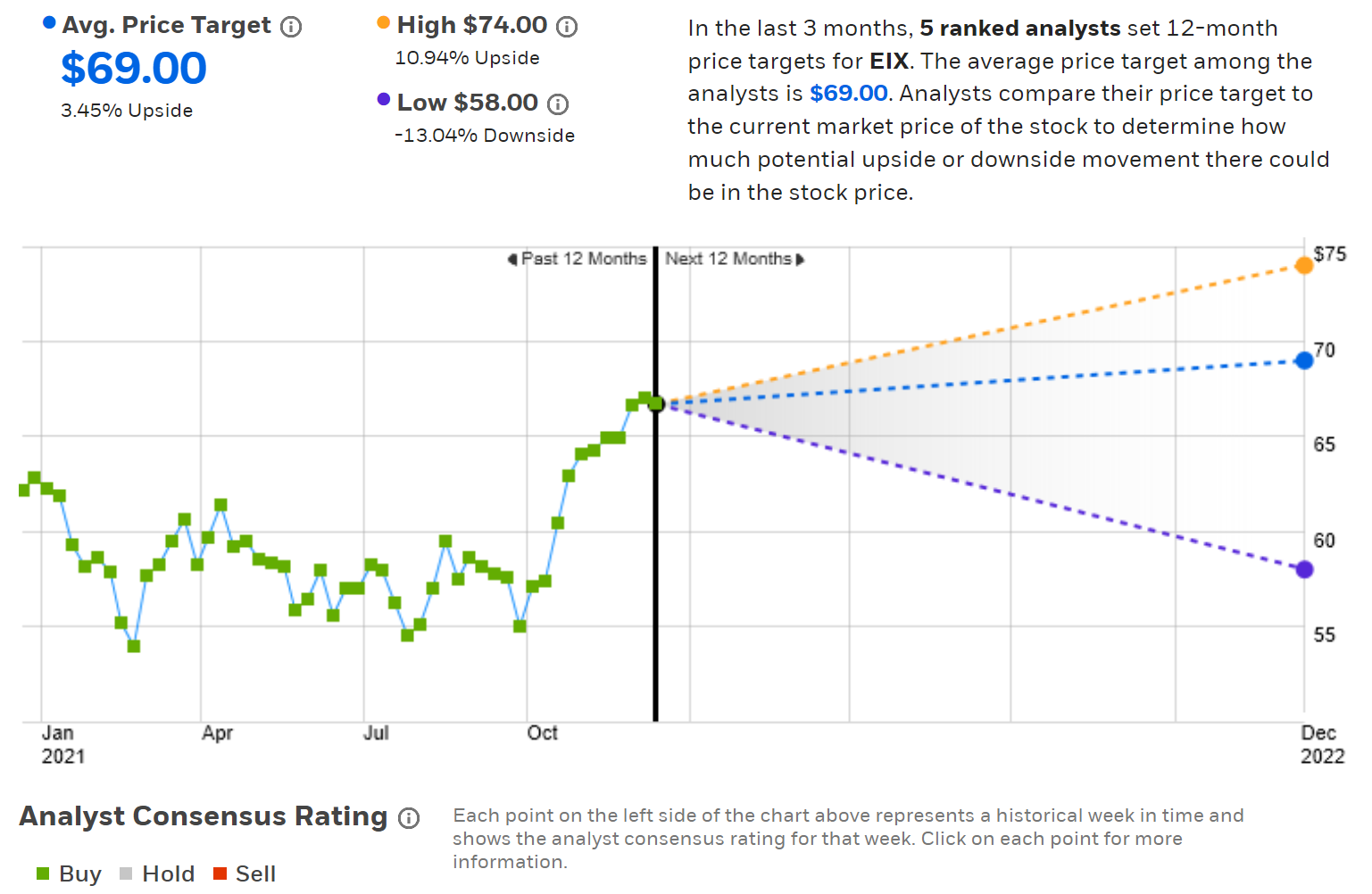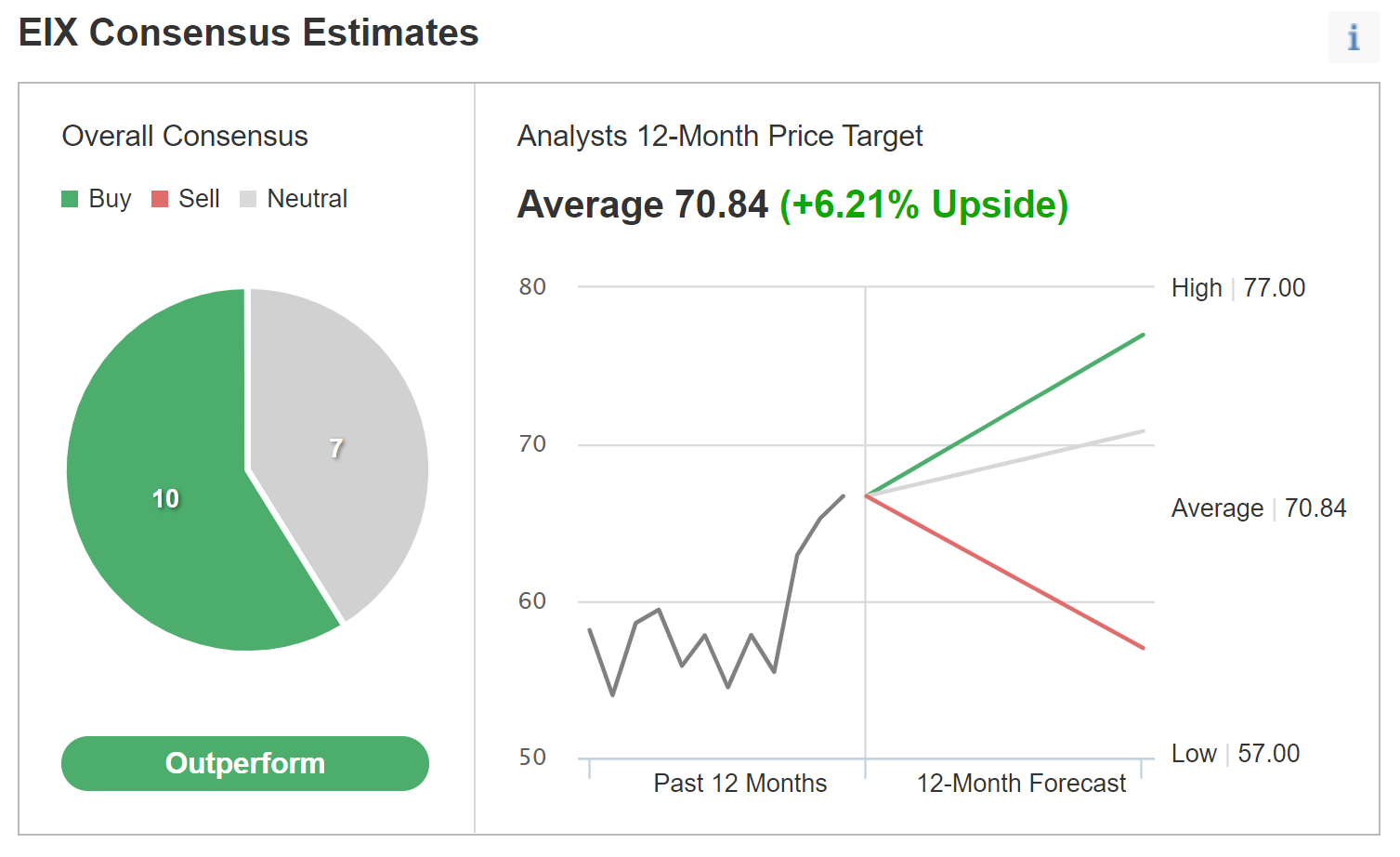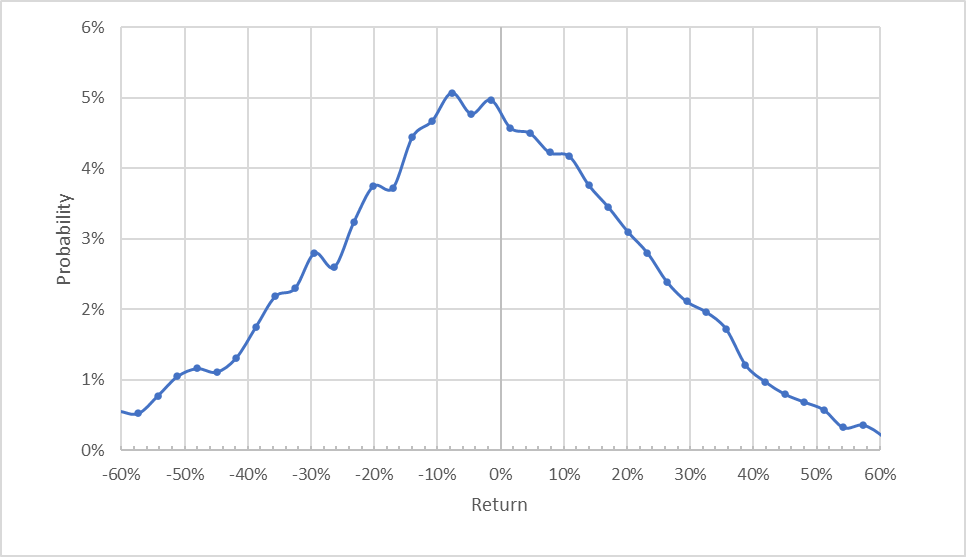- Edison International recently raised its dividend and currently yields 4.2%
- The shares have rallied over the past 3 months
- The potential liabilities from wildfires are large and hard to estimate
- The Wall Street consensus is bullish, albeit with very limited upside
- The market-implied outlook (calculated from options prices) is neutral for 2022
Edison International (NYSE:EIX) owns Southern California Edison (SCE), a major utility which supplies power to 15 million Californians over a 50,000 square mile service area. EIX also owns Edison Energy, a global advisory and services firm. SCE faces major uncertainty and ongoing risks associated with liability for wildfires and recently agreed to pay $550 million in fines as a result of safety violations that caused major fires in 2017 and 2018.
EIX reported Q3 earnings on Nov. 2, with EPS slightly below the consensus expectations. This was also the case for Q2, reported on July 29.

Source: Investing.com
EIX has returned a total of 9.34% YTD after gaining 16.65% over the past 3 months. Even with the recent rally, EIX’s total return lags the utility sector over the past year. The Utilities Select Sector SPDR® Fund (NYSE:XLU) had a total return of 14.95% over the most recent 12 months, as compared to 10.25% for EIX. Over the longer term, for the trailing 3-, 5-, and 10-year periods, the shares have also underperformed the regulated electric utility sector. The shares remain substantially below the pre-COVID 2020 high close of $78 on Feb. 11.
Source: Morningstar
On Dec. 10, EIX announced a dividend increase, and the forward yield is 4.2%. Despite ongoing costs and concerns about wildfire risk in the company’s service area, the company has now raised the dividend for 17 consecutive years. The 3-, 5-, and 10-year annualized dividend growth rates are 3.1%, 6.7%, and 7.6%, respectively.
While SCE is engaging in a variety of wildfire mitigation activities, extreme drought conditions persist across California. The question for investors is whether the shares are trading at a sufficiently-attractive valuation to justify the economic risks associated with fire liability.
To address this question, I rely on two forms of consensus outlooks for EIX. The first is the well-known Wall Street analyst consensus rating and 12-month price target. The second is the market-implied outlook, a probabilistic price forecast calculated from options prices. The market-implied outlook is of particular interest because it shows how the market is pricing downside risk for EIX. The prices of options reflect the market’s consensus estimates of the probability of price gains or losses. The market-implied outlook shows the distribution of price returns that reconciles the options prices.
Wall Street Analyst Consensus Outlook for EIX
E-Trade calculates the Wall Street consensus outlook for EIX by combining the views of 5 ranked analysts who have published ratings and price targets over the past 90 days. The consensus rating is bullish and the consensus 12-month price target is 3.45% above the current share price. The consensus rating for EIX has been bullish through all of 2021.

Source: E-Trade
Investing.com’s version of the Wall Street consensus is calculated using ratings and price targets from 17 analysts. The consensus rating is bullish and the consensus price target is 6.2% above the current share price.

Source: Investing.com
The prevailing view among the Wall Street analysts is that EIX is a buy, although the expected 12-month price target is not far above the current share price. With expected price appreciation of 3.5% or 6.2%, depending on the source of the consensus estimate, the projected 12-month total return is 7.5% to 10.4% (average of 8.95%). The high end of this range is close to the total return over the most-recent 12 months and the average is comparable to the 10-year annualized return.
Market-Implied Outlook for EIX
The price of an option on a stock reflects the market’s estimate of the probability that the shares will rise above (call option) or fall below (put option) a specific level (the option strike price) between now and when the option expires. By analyzing the prices of options at a range of strike prices, all with the same expiration date, it is possible to calculate a probabilistic price return forecast that reconciles the option prices. This is the market-implied outlook.
I have calculated the market-implied outlook for EIX for the 13-month period from now until Jan.20, 2023 by analyzing the prices of options that expire on that date. I chose to analyze these options because this is the expiration date that is closest to 1 year into the future.
The options trading on EIX is very thin, which reduces confidence in the meaningfulness of the market-implied outlook. This also suggests that there is not a lot of money betting on bad outcomes. This is consistent with the low short interest, 1.52% of the percentage of shares.
The standard presentation of the market-implied outlook is in the form of a probability distribution of price return, with probability on the vertical axis and return on the horizontal axis.

Source: Author’s calculations using options quotes from E-Trade
The market-implied outlook for EIX is generally symmetric, with comparable probability of positive and negative returns of the same size, although the peak in probabilities is tilted to favor negative price returns over the next 13 months.
The annualized volatility calculated from this distribution is 26.6%. This is a fairly low level of volatility for an individual stock, but high compared to other utility companies. In a recent analysis of Consolidated Edison (NYSE:ED), for example, the annualized volatility calculated from the market-implied outlook was 20.5%. In an October analysis of Southern Company (NYSE:SO), the market-implied annualized volatility was 20.4%. EIX has expected volatility that is 30% higher than those of SO and ED.
To make it easier to directly compare the probabilities of positive and negative returns, I rotate the negative return side of the distribution about the vertical axis (see chart below).

Source: Author’s calculations using options quotes from E-Trade. The negative return side of the distribution has been rotated about the vertical axis.
This view shows that the market-implied probabilities of negative returns are consistently higher than for positive returns of the same magnitude (the red dashed line is above the solid blue line across the entire chart).
Theory suggests that the market-implied outlook is expected to have a negative bias because investors, in aggregate, tend to be risk averse and thus willing to pay more than fair value for downside protection. There is no objective way to measure this effect. The modestly higher probabilities for negative returns is consistent with the existence of this type of negative tilt. As such, the best interpretation is that this market-implied outlook is neutral for the 13-month period.
Summary
I don’t know why investors would choose to own EIX, as opposed to buying a utility index fund, such as XLU, or shares of a high-yield utility that is not bearing the kind of extreme loss potential from wildfires.
EIX has a higher dividend yield than XLU (2.8% yield), but only slightly higher than the yield from Duke Energy (NYSE:DUK) (3.8% yield) or Southern Company (3.9% yield).
While EIX trades at a low P/E ratio as compared to DUK, SO and the industry as a whole, this does not mean the shares are undervalued. The substantial idiosyncratic risks faced by EIX certainly justify some discount.
The expected volatility calculated from the market-implied outlook for EIX is 30% higher than for two other major utilities with comparable yields, SO and ED. This is consistent with the market assigning elevated risk for EIX.
The Wall Street analyst consensus outlook for EIX is bullish, and the 12-month consensus price target implies a total return of 8.95%. As a rule of thumb for a buy rating, I want to see an expected 12-month return that is at least half the expected annualized volatility (26.6%). EIX does not meet this criterion. The market-implied outlook for the next 13 months is neutral.
While EIX appears to be moving in the right direction, dealing with the company’s liabilities from 2017-2018 fires and improving operations to reduce future risk, the potential returns on EIX are not attractive relative to the risks. I am assigning a neutral rating for EIX.
